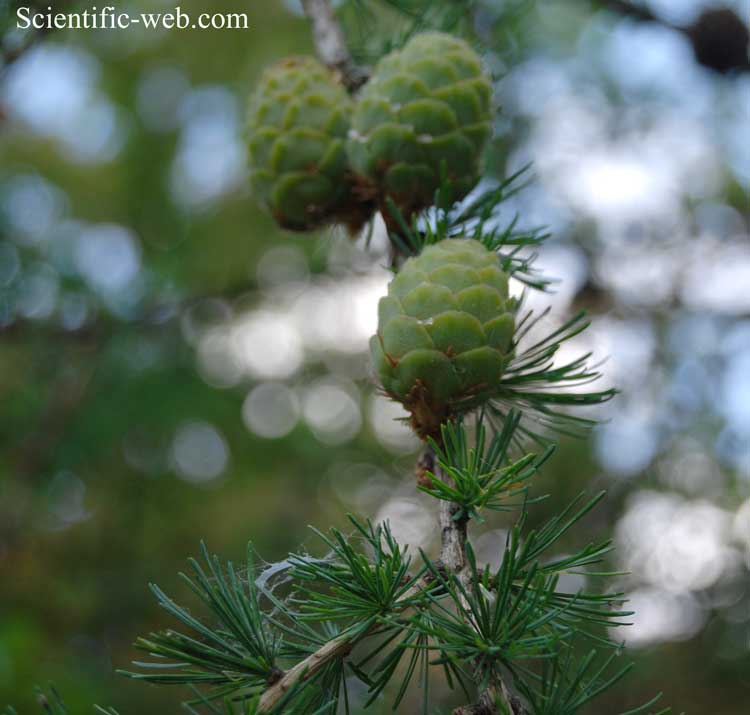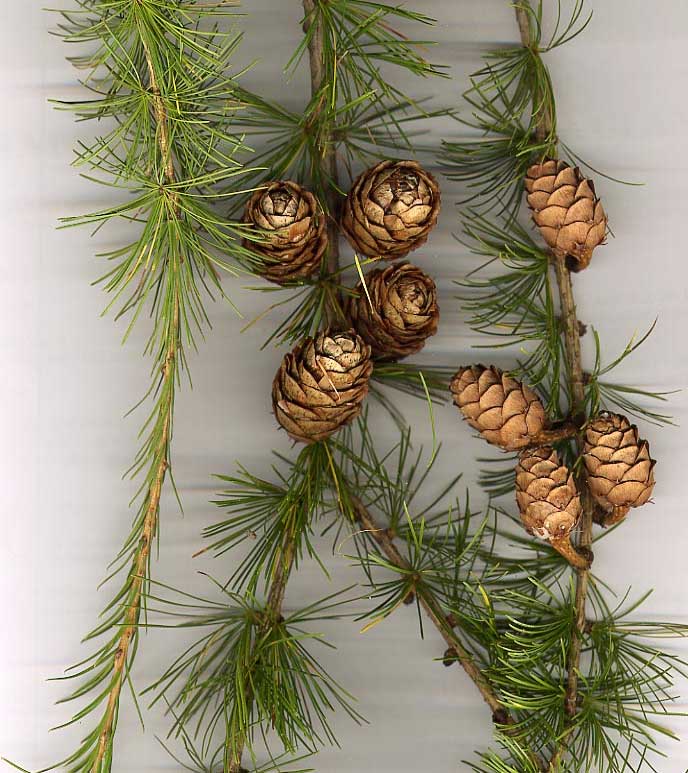
Larix decidua, Photo: Michael Lahanas
Superregnum: Eukaryota
Regnum: Plantae
Divisio: Tracheophyta
Divisio: Pinophyta
Classis: Pinopsida
Ordo: Pinales
Familia: Pinaceae
Genus: Larix
Species: Larix decidua
Varietates: L. d. var. carpatica – L. d. var. decidua – L. d. var. polonica
Name
Larix decidua Mill., Gard. Dict. ed. 8: n.º 1 (1768).
Synonyms
Replaced synonym
Pinus larix L., Sp. Pl.: 1001 (1753).
Homotypic
Pinus laeta Salisb., Prodr. Stirp. Chap. Allerton: 399 (1796), nom. superfl.
Abies larix (L.) J.St.-Hil., Expos. Fam. Nat. 2: 330 (1805).
Larix pyramidalis Salisb., Trans. Linn. Soc. London 8: 313 (1807), nom. superfl.
Peuce larix (L.) Rich., Ann. Mus. Hist. Nat. 16: 298 (1810).
Larix communis Lindl. in J.C.Loudon, Encycl. Pl.: 806 (1829), nom. superfl.
Picea larix (L.) Peterm., Pflanzenreich: 236 (1838-1845).
Larix vulgaris Fisch. ex Spach, Hist. Nat. Vég. 11: 432 (1841), nom. superfl.
Larix larix (L.) H.Karst., Deut. Fl.: 326 (1881), not validly publ.
Distribution
Native distribution areas:
Europe
Middle Europe
Austria, Czechoslovakia, Germany, Poland, Switzerland.
Southwestern Europe
France.
Southeastern Europe
Italy, Romania, Yugoslavia.
References: Brummitt, R.K. 2001. TDWG – World Geographical Scheme for Recording Plant Distributions, 2nd Edition
References
Additional references
Tutin, T.G., Burges, N.A., Chater, A.O., Edmondson, J.R., Heywood, V.H., Moore, D.M., Valentine, D.H., Walters, S.M. & Webb, D.A. (eds.) 1993. Flora Europaea. Volume 1: Psilotaceae to Platanaceae. 2nd edition, Cambridge University Press, Cambridge (UK) / New York / Melbourne, xlvi + 581 pp., ISBN 0-521-41007-X. Reference page.
Farjon, A. 2001. World Checklist and Bibliography of Conifers. 2. ed., 309 pp. The Royal Botanic Gardens, Kew. ISBN 1-84246-025-0 Reference page.
Farjon, A. 2010. A Handbook of the World's Conifers. Koninklijke Brill, Leiden. ISBN 90-04-17718-3. Reference page.
Links
Govaerts, R. et al. 2021. Larix decidua in World Checklist of Selected Plant Families. The Board of Trustees of the Royal Botanic Gardens, Kew. Published online. Accessed: 2021 February 28. Reference page.
International Plant Names Index. 2021. Larix decidua. Published online. Accessed: 28 February 2021.
Vernacular names
مصرى: ارزيه اوروبيه
العربية: أرزية أوروبية
azərbaycanca: Avropa qara şamı
Boarisch: Larch
žemaitėška: Ieglė
беларуская: Лістоўніца еўрапейская
български: Европейска лиственица
bosanski: Evropski ariš
català: Làrix europeu
kaszëbsczi: Eùropejsczi skòwrónk
čeština: Modřín opadavý
Cymraeg: Llarwydden Ewrop
dansk: Europæisk Lærk
Deutsch: Europäische Lärche
dolnoserbski: Europski larik
English: European Larch
Esperanto: Eŭropa lariko
español: Alerce europeo
eesti: Euroopa lehis
euskara: Europar laritz
فارسی: سیاهکاج اروپایی
suomi: Euroopanlehtikuusi
français: Mélèze d'Europe
Gaeilge: Learóg Eorpach
hrvatski: Europski ariš
hornjoserbsce: Europski larik
magyar: Európai vörösfenyő
հայերեն: Խեժափիճի եվրոպական
íslenska: Evrópulerki
italiano: Larice comune
日本語: ヨーロッパカラマツ
перем коми: Европаись лисвень
lietuvių: Europinis maumedis
latviešu: Eiropas lapegle
македонски: Европски ариш
Nederlands: Europese lork
norsk: Europalerk
polski: Modrzew europejski
português: Lariço-europeu
rumantsch: Laresch
română: Zada
русский: Лиственница европейская
srpskohrvatski / српскохрватски: Evropski ariš
slovenčina: Smrekovec opadavý
slovenščina: Navadni macesen
српски / srpski: Европски ариш
svenska: Lärk
Türkçe: Avrupa melezi
українська: Модрина європейська
vèneto: Làrese
中文: 欧洲落叶松
Larix decidua, the European larch, is a species of larch native to the mountains of central Europe, in the Alps and Carpathian Mountains as well as the Pyrenees, with disjunct lowland populations in northern Poland and southern Lithuania. It is widely naturalized in Scandinavia. Its life span has been confirmed to be close to 1000 years [3] (with claims of up to 2000 years) but is more often around 200 years.[4] It is claimed that one of the larches planted by the second Duke of Atholl at Dunkeld in 1738 is still standing.[5]

Larix decidua (*)
Description
European larch morphology features from book: Prof. Dr. Otto Wilhelm Thomé Flora von Deutschland, Österreich und der Schweiz, 1885, Gera, Germany.
Larix decidua is a medium-size to large deciduous coniferous tree reaching 25–45 m tall, with a trunk up to 1 m diameter (exceptionally, to 53.8 m tall and 3.5 m diameter). The crown is conic when young, becoming broad with age; the main branches are level to upswept, with the side branches often pendulous. The shoots are dimorphic, with growth divided into long shoots (typically 10–50 cm long) and bearing several buds, and short shoots only 1–2 mm long with only a single bud. The leaves are needle-like, light green, 2–4 cm long which turn bright yellow before they fall in the autumn, leaving the pale yellow-buff shoots bare until the next spring.
The cones are erect, ovoid-conic, 2–6 cm long, with 10-90 erect or slightly incurved (not reflexed) seed scales; they are green variably flushed red when immature, turning brown and opening to release the seeds when mature, 4–6 months after pollination. The old cones commonly remain on the tree for many years, turning dull grey-black.
It is very cold tolerant, able to survive winter temperatures down to at least -50 °C, and is among the tree line trees in the Alps, reaching 2400 m altitude, though most abundant from 1000–2000 m. It only grows on well-drained soils, avoiding waterlogged ground and is not shade tolerant.
Cultivation
It is thought to have been first cultivated in Britain in 1629.[6] John Evelyn encouraged its wider planting and use.[7] Three successive Dukes of Atholl planted it widely[8] and the fourth Duke wrote "Observations on Larch" in 1807 encouraging further its cultivation, which he practiced on a large scale.[9]
European larch is widely cultivated in southern Canada and the northeastern United States. It has been naturalized in Maine, Michigan, New York, Connecticut, New Hampshire, Vermont, and Rhode Island. In the northern Appalachian Mountains it is often used for the reforestation of surface mines.[10] European larch can grow on drier soils and tolerate warmer climates than the native tamarack, being better suited to non-boreal climates.[11]
Subtaxa
The following varieties are accepted:[2]
Larix decidua var. carpatica Domin – the Carpathians
Larix decidua var. decidua – European larch or Alpine larch. Most of the range, except as below. Cones 2.5–6 cm; shoots yellow-buff.
Larix decidua var. polonica (Racib. ex Wóycicki) Ostenf. & Syrach – Polish larch. Disjunct in lowland northern Poland. Cones 2–3 cm; shoots very pale yellow-buff, almost white.
Uses
Larix decidua is cultivated as an ornamental tree for planting in gardens and parks.[12]
Wood
The wood is tough and durable, but also flexible in thin strips, and is particularly valued for yacht building; wood used for this must be free of knots, and can only be obtained from old trees that were pruned when young to remove side branches.
Small larch poles are widely used for rustic fencing.
Other
Because of its fast juvenile growth and its pioneer character, larch has found numerous applications in forestry and agroforestry. It is used as a ‘preparatory species’ to afforest open land, abandoned farmland or disturbed land and as a ‘nurse species’ prior to the introduction of more demanding species.[13]
Bonsai
The European larch is a popular bonsai species, with many unique specimens available in European circles, and is popularly used in bonsai forest groups.[14]
Ecology
The seeds are an important food for some birds, notably siskin, lesser redpoll and citril finch, while the buds and immature cones are eaten by capercaillie.
See also: List of Lepidoptera that feed on larches
European larch needles are the only known food for caterpillars of the case-bearer moth Coleophora sibiricella; its cone scales are used as food by the caterpillars of the tortrix moth Cydia illutana.
Invasive species
Larix decidua is classed as a wilding conifer, an invasive species which spreads into the high country of New Zealand. It was planted by the New Zealand Forest Service for erosion control.
References
Farjon, A. (2017). "Larix decidua". IUCN Red List of Threatened Species. 2017: e.T42309A83969267. doi:10.2305/IUCN.UK.2017-2.RLTS.T42309A83969267.en. Retrieved 19 November 2021.
"Larix decidua Mill". Plants of the World Online. Board of Trustees of the Royal Botanic Gardens, Kew. 2017. Retrieved 11 April 2021.
"Larix decidua (Europäische Lärche) description - The Gymnosperm Database". www.conifers.org. Retrieved 2017-12-07.
http://www.plantwise.org/KnowledgeBank/Datasheet.aspx?dsid=29967
"Archived copy". Archived from the original on 2016-03-04. Retrieved 2016-01-11.
Parkinson, Paradisus
The Gardener's Dictionary, Vol.1, Philip Miller, 1835
A History of British Forest-trees: Indigenous and Introduced, Prideaux John Selby, 1842
The Philosophical Magazine and Journal, Vol. 53, 1819
"Larix decidua". US Forest Service. Retrieved 13 July 2016.
Perry, Leonard. "Larches Large and Small". University of Vermont Extension. Retrieved 13 July 2016.
"Larix decidua". Royal Horticultural Society. Retrieved 23 July 2013.
Matras, Jan; Pâques, Luc E. (2008). "European Larch, Larix decidua: Technical guidelines for genetic conservation and use" (PDF). European Forest Genetic Resources Programme.
D'Cruz, Mark. "Ma-Ke Bonsai Care Guide for Larix decidua". Ma-Ke Bonsai. Archived from the original on 2012-05-14. Retrieved 2011-07-08.
Retrieved from "http://en.wikipedia.org/"
All text is available under the terms of the GNU Free Documentation License

